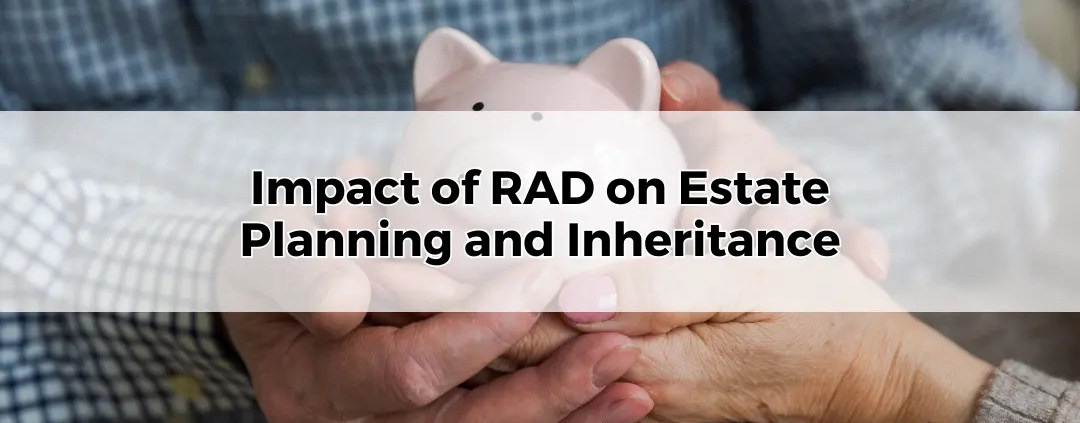Impact of RAD on Estate Planning and Inheritance
Table of Contents
ToggleThe Refundable Accommodation Deposit (RAD) plays a pivotal role in Australia’s aged care system, but its impact extends far beyond funding accommodation. For individuals entering aged care, the RAD represents a substantial financial commitment, often requiring large lump-sum payments that can significantly alter an estate’s structure. For families, understanding the implications of the RAD is crucial, particularly when considering inheritance and estate planning. This article explores how the RAD influences these financial decisions, highlighting the importance of foresight and strategic planning to mitigate its effects.
What is a Refundable Accommodation Deposit (RAD)?
A Refundable Accommodation Deposit (RAD) is a one-time, upfront payment that covers the cost of accommodation in aged care facilities. It serves as a means for residents to secure a place in the facility, with the government regulating the maximum allowable amount. While the RAD is refundable when the resident leaves the facility or passes away, it ties up a considerable portion of personal wealth during the resident’s time in care. This, in turn, affects liquidity, estate value, and financial planning, making it essential to understand its role when navigating aged care arrangements.
How RAD Impacts the Financial Structure of Your Estate
The RAD’s substantial size often forces individuals and their families to reconsider their financial structure. A large lump-sum payment can significantly reduce the liquid assets available within the estate, affecting the funds that would otherwise be available for distribution to beneficiaries. This can lead to adjustments in the allocation of assets or a need to reconsider how remaining wealth is managed. Furthermore, the placement of a RAD within estate planning means that estate liquidity becomes a concern, as other investments may need to be sold to maintain a balance between care costs and inheritance.
RAD Versus Other Accommodation Payment Options
Aged care facilities typically offer alternative payment structures to the RAD, including the Daily Accommodation Payment (DAP) or a combination of both RAD and DAP. Choosing between these options has a direct impact on estate planning. A full RAD locks away a large sum but may offer peace of mind regarding accommodation. Conversely, a DAP or combination option allows greater liquidity but may cost more over time. Each choice carries different financial repercussions, particularly regarding how much of the estate remains intact for distribution after care costs are covered.
RAD and Its Influence on Estate Planning Decisions
Integrating the RAD into estate planning requires careful consideration. The lump-sum nature of the RAD can upend traditional estate planning strategies, particularly when significant assets are involved. Estate plans that previously relied on large cash reserves or liquid assets may need to be restructured to accommodate the RAD payment. This often means that assets intended for inheritance, such as investment portfolios or property, may need to be repurposed to cover the RAD, diminishing the overall value of the estate for heirs.
Selling Assets to Fund RAD
One of the most challenging aspects of funding a RAD is the potential need to sell assets, such as property or investments, to generate the necessary funds. This can reduce the overall value of the estate and leave less for heirs. The timing of asset sales can also affect estate value, as market fluctuations may force sales at less favourable prices. Additionally, selling key assets like the family home can be emotionally taxing, as it involves parting with a significant piece of family history. The long-term financial and emotional consequences must be weighed carefully in the decision-making process.
The Refundability of RAD and Its Implications for Heirs
The RAD is refundable, but this does not always mean the full amount will be returned immediately or in its entirety. The timing of the refund can be delayed, particularly if the aged care provider takes time to process the return, which may leave heirs waiting to access the funds. Additionally, while the RAD is designed to be returned upon death or departure from care, any outstanding fees or charges may be deducted from the refund, reducing the final amount available to the estate. Understanding these conditions is essential for both estate planning and managing heirs’ expectations.
Minimising Tax Implications When Paying RAD
The source of funds used to pay the RAD can have tax implications, particularly if the payment comes from the sale of assets that trigger capital gains or other tax liabilities. For instance, selling an investment property to fund the RAD could result in significant capital gains tax, thereby reducing the amount of the estate that can be passed on to beneficiaries. Strategies such as staggered asset sales or utilising tax-efficient savings vehicles can help minimise these tax burdens, preserving more of the estate for inheritance.
RAD’s Impact on Superannuation and Retirement Income Streams
Superannuation and retirement income streams are commonly used to fund aged care costs, including the RAD. However, drawing on superannuation to cover a RAD can significantly reduce the income available for other living expenses or future care needs. Moreover, accessing superannuation prematurely can affect tax liabilities and reduce the amount available for inheritance. Balancing the use of superannuation with other financial resources is critical to ensuring that care costs are met without entirely depleting retirement savings or leaving the estate barren.
Balancing Care Costs with Preserving Inheritance
One of the key challenges families face when funding aged care through a RAD is finding the right balance between meeting care costs and preserving as much of the estate as possible for future generations. This often involves difficult decisions about how assets are allocated, whether the family home should be sold, or if income-generating investments should be liquidated. Effective planning can help strike a balance, ensuring care costs are met while safeguarding as much of the estate as possible for beneficiaries.
Gifting and RAD
In some cases, individuals may choose to gift assets to family members before entering aged care as part of a broader estate planning strategy. However, gifting can affect the amount of assets available to fund a RAD, potentially increasing the reliance on remaining estate resources. Additionally, gifting within the five years preceding a move into aged care may still be assessed under Centrelink’s means-testing rules, which can increase aged care fees. Careful consideration of the timing and size of gifts is necessary to avoid unintended consequences for both RAD funding and estate value.
The Importance of Early Planning to Navigate RAD’s Impact
Navigating the financial implications of a RAD requires foresight and early planning. By preparing ahead of time, families can explore strategies to fund the RAD without unnecessarily depleting the estate. Early planning also allows for greater flexibility in asset management, enabling families to make informed decisions about how to balance care costs with preserving inheritance. Whether through the strategic use of financial products, reallocation of assets, or the sale of property, early action can significantly mitigate the RAD’s impact on estate planning and inheritance.
Conclusion
The Refundable Accommodation Deposit, while essential for securing aged care, can have a profound effect on estate planning and inheritance. By understanding how the RAD influences financial decisions, families can better prepare for the challenges it presents. Strategic planning, including asset management, tax considerations, and superannuation use, is key to ensuring that both care costs and inheritance goals are met. The RAD need not be a financial burden if addressed early and with the right advice, allowing families to focus on care without sacrificing their financial legacy.









